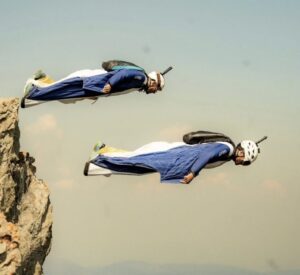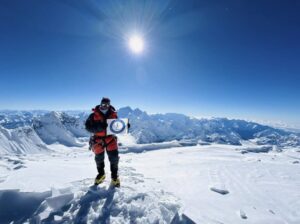Should a summit officially count when a climber doesn’t make it down by his or her own means? The question is particularly relevant in the wake of the dramatic events on Annapurna two weeks ago.
Helicopters on Annapurna
Helicopter pilots were busy around Annapurna on April 18. Baljeet Kaur, who had been reported dead the day before, miraculously sent an SOS message from above Camp 4. It prompted an aerial search and a high-risk long-line rescue from 7,400m.
Further flights transported at least five other climbers, stuck in higher camps after an avalanche swept away some of the fixed ropes. After 24 hours, all were running out of oxygen, food, and fuel.
A potentially tragic day thus evolved into a story of survival and good news. But as the injured climbers recovered, a more practical question arose. Are the summits achieved by those airlifted to safety valid? Especially, should they count for records and quests such as the 14×8,000’ers?
We have asked both the statisticians and the climbers themselves.

Jonathan Lamy high up on Annapurna during his summit push, wearing an air-warming mask. (He climbed no-O2.) Photo: Jonathan Lamy/Facebook
What climbers think
“Many people talk and talk about mountaineering without climbing [themselves],” Jonathan Lamy of France told ExplorersWeb. “They try to set rules about everything but hey, this is just mountaineering, not the Olympics.”
Lamy summited Annapurna without supplementary oxygen, but a helicopter evacuated him two days later with second-degree frostbite in his toes.
“I had a good reason to ask for a rescue,” he explained. “I am a climber, not a superhero. Honestly, I prefer people saying that I should not have my summit count because of the airlift than to lose my toes.”

Jonathan Lamy took his picture of his own injured feet from his hospital bed. Photo: Jonathan Lamy/Facebook
“On the night of April 17, Annapurna was chaos,” Shehroze Kashif told ExplorersWeb. “We heard Baljeet [Kaur] was dead, Anurag [Maloo] was dead, Noel [Hanna] was dead, and the ropes were cut below us. No wonder the company wanted us to be picked up for our safety. But I did reach the summit, climbed to the highest point, so for me, it definitely counts.”

Shehroze Kashif, right, with Noel Hanna, who died in Camp 4 while returning from the summit on April 17.
Kashif added: “Nowadays, helicopters are used all the time to carry gear and oxygen to higher camps…So from that point of view, everybody is using helicopters somehow. Strictly speaking, no one’s summit should be valid anymore.”
Naila Kiani is not so sure. “I’m confused,” she admitted to ExplorersWeb. “I’m getting congratulatory messages from legendary climbers like Nazir Sabir and so many others, and I don’t know how to respond to those messages.
“I did reach the summit but I didn’t climb down to the Base Camp. This is not the outcome I wanted. Although I should be happy about reaching the top, deep down I’m not. Well, I am happy to be alive and back with my daughters!”

Tashi Sherpa and Naila Kiani on Annapurna summit. Photo: Tashi Sherpa/Instagram
The statisticians’ take
Billi Biering of The Himalayan Database explains that the summit listings of these evacuees will include an asterisk. “The summiters will get an aviation-assisted note on the database,” she said.
What about those pursuing some kind of record, such as an age record or the first person from their country to climb a peak? Luckily for Bierling and her team, they don’t list records, so don’t have to be arbiters of the first and the fastest.
“I think that is the job for the people who note records, such as Guinness,” Bierling said.
Says Eberhard Jurgalski of 8000ers.com, “In my humble opinion, an ascent is valid, even when you are airlifted from higher camps because of health problems or weather. It also applies to climbers who die on the way down after summiting.”
That would apply to Noel Hanna, who passed away at Camp 4 on his way down from the top. His remains were retrieved and airlifted out on April 18.

The helicopter at Annapurna Base Camp, ready for long-line rescues. Photo: Courtesy of Moeses Fiamoncini
But Jurgalski adds that using helicopters in other ways is not valid: “You must start at Base Camp and climb all the way to the summit, not after a helicopter flight to a higher camp.” He confirms that there may have been cases of this that are currently under investigation.
Jurgalski’s flexible approach seemingly acknowledges that a helicopter is just a tool to perform a rescue. It’s better and faster than the traditional method, where climbing partners or Sherpas carry an ailing member down. The nuance comes, as we’ll see, if the helicopter pickup is not strictly a rescue.
Ed Viesturs: round trip vital
Generally, seasoned high-altitude climbers, especially those who operated before helicopters were everywhere in the Himalaya, believe the old saying that “the climb ends not on the summit but back in Base Camp.”
U.S. 14×8,000’er summiter Ed Viesturs supported this view in an article for GearJunkie last year.
“I’ve always believed climbing a mountain has to be a round trip,” Viesturs wrote. “The second half of any climb, the descent, is the most important part of the actual event.”

Ed Viesturs on Aconcagua. Photo: Ed Viesturs/Facebook/HIMALI
Independent climber vs client
In his GearJunkie article, Viesturs continued: “If you don’t have the strength, endurance, desire, or motivation to descend the entire way from the summit back to base camp, then perhaps you should rethink your reasons for climbing or your system of training for such an endurance event.”

A higher camp on Annapurna this spring. Photo: Seven Summit Treks
Viesturs, notably, speaks from the point of view of a self-sufficient, independent climber. But with commercial, guided teams, which include many clients with little climbing experience, the responsibility lies with the team leader. Often, teams rely heavily on O2 to replace proper acclimatization, and engage in extremely long summit pushes which leave the clients exhausted.
In such circumstances, they are vulnerable to anything that could go wrong – and on Annapurna, several elements did. Ropes cut by avalanches, extreme cold, dwindling oxygen supplies, a coming snowstorm, and everyone exhausted from pushes that in some cases lasted over a day. If not for the helicopters, the episode could have ended in tragedy.
Pilots performed numerous airlifts on Annapurna in very difficult conditions, in worsening weather. At great personal danger to themselves, they helped people who had voluntarily climbed an objectively dangerous mountain. These days, helicopter pilots are often the real heroes. But sometimes, it seems that they are compensating for inadequate skills and sensible planning.
Aero-taxi service
Finally, there is an important nuance that traditional mountaineers would have not even considered: ordering a helicopter ride not because of an emergency but just for comfort.
This trend started with lifts back to town from base camps, sparing tired climbers the long trek back. It has now expanded to the mountains themselves. It is not yet frequent, and it is expensive, but it does occur. In 2021 on Everest, members of a big team from Bahrain allegedly flew down from Camp 2 to avoid crossing back through the Khumbu Icefall. It happens on other mountains too, where helicopters carry gear to higher camps, then bring someone down on the return flight.

Rescue pilot Sobit Gauchan, one of the specialists who took part in the Annapurna rescues. Photo: Sobit Gauchan/Instagram
Some might argue that it also occurs in the Alps, where climbers often approach their peaks by cable car. However, that would be more similar to the airlift from Base Camp, since the climb itself begins beyond that.
Sometimes it is hard to tell a rescue from an aero-taxi service, as insurance companies covering rescues know too well. On April 18 on Annapurna, after the climbers were airlifted to the hospital, their Sherpas made it down by their own means. Part of a Nepal army team also made it down on foot.
As for “exhausted” climbers, how tired is too tired? Twenty years ago, everyone knew that the climb finished at Base Camp and behaved accordingly. They knew that descent was where most accidents happened. They had to manage their summit push by leaving enough energy for the way down. And if they weren’t feeling well enough, they turned around. At least, many of them did.

Annapurna. Photo: Seven Summit Treks






